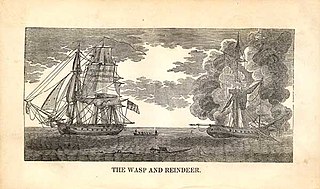
HMS Reindeer was a Royal Navy 18-gun Cruizer-class brig-sloop of the Royal Navy, built by Samuel & Daniel Brent at Rotherhithe and was launched in 1804. She was built of fir, which made for more rapid construction at the expense of durability. Reindeer fought in the Napoleonic Wars before succumbing in 1814 to the guns of USS Wasp during the War of 1812.

HMS Recruit was an 18-gun Cruizer-class brig-sloop of the Royal Navy, launched in 1806 at Sandwich, Kent. She is best known for an act of pique by Commander Warwick Lake, who marooned a seaman, and for an inconclusive but hard-fought ship action under Commander Charles John Napier against the French corvette Diligente. She captured a number of American vessels as prizes during the War of 1812 before being laid up in 1815 and sold for breaking up in 1822.

Rhin was a 40-gun Virginie-class frigate of the French Navy launched in 1802. She was present at two major battles while in French service. The Royal Navy captured her in 1806. Thereafter Rhin served until 1815 capturing numerous vessels. After the end of the Napoleonic Wars she was laid up and then served as a hospital for many years. She was finally broken up in 1884.

Surveillante entered service as a 40-gun Virginie-class frigate of the French Navy. She was surrendered to the British in 1803, after which she served in the Royal Navy, classed under the British system as a 38-gun vessel, until 1814 when she was decommissioned. HMS Surveillante had a long and active career under two successful and distinguished commanders, from the Baltic to the northwestern coasts of France, Spain and Portugal, and was present at the Battle of Copenhagen (1807) and throughout the Peninsula War. Her record as a taker of prizes is notable for its success, particularly towards the end of her career.

HMS Lynx was a 16-gun ship-rigged sloop of the Cormorant class in the Royal Navy, launched in 1794 at Gravesend. In 1795 she was the cause of an international incident when she fired on USRC Eagle. She was at the Battle of Copenhagen in 1801, and during the French Revolutionary and Napoleonic Wars took numerous prizes, mostly merchant vessels but also including some privateers. She was also at the second Battle of Copenhagen in 1807. She was sold in April 1813. She then became the whaler Recovery. She made 12 whaling voyages in the southern whale fishery, the last one ending in 1843, at which time her owner had her broken up.
HMS Pheasant was an 18-gun merlin class sloop of the Royal Navy.

HMS Clyde was a Royal Navy Artois-class frigate built at Chatham Dockyard of fir, and launched in 1796. In 1797, she was one of only two ships whose captains were able to maintain some control over their vessels during the Nore mutiny. In 1805, HMS Clyde was dismantled and rebuilt at Woolwich Dockyard; she was relaunched on 23 February 1806. She was ultimately sold in August 1814.
HMS Pert was the French privateer Bonaparte, a ship built in the United States that HMS Cyane captured in November 1804. The Royal Navy took Bonaparte into service as HMS Pert. Pert was wrecked off the coast of what is now Venezuela in October 1807.
Éole was an 18-gun corvette of the French Navy, launched, captured, and later commissioned in the Royal Navy in 1799 as HMS Nimrod after her capture by HMS Solebay. She was then "the finest and most handsome ship-sloop in the British navy". She was sold in 1811. Nimrod made three whaling voyages between 1811 and 1819. On her first she captured several American whalers. Nimrod was last listed in 1820.
Three vessels of the British Royal Navy have borne the name HMS Rolla:
Ann or Anne has been a popular name for ships.
Monarch was built at Quebec in 1800. She sailed to England, being captured and recaptured shortly before arriving. In England, under new ownership, she proceeded to make five voyages for the British East India Company (EIC) as an "extra ship", that is, under voyage charter. In 1813 she became a transport, and then in 1818 or so a regular merchantman. She was broken up in 1820.
HMS Acteon, was the brig Actéon, launched in France in 1804 as the second of the two-ship Lynx-class. The British Royal Navy captured her in 1805 but laid her up. The Navy finally commissioned her in 1809. She was at the British invasion of Île de France and later served in the Channel, the North Sea, the Baltic, and the Chesapeake. She was broken up in 1816.
Dame Ernouf first appears under that name in 1807. Her origins are currently obscure. She served as a privateer first under that name, and then under the name Diligent. As Diligent she not only capture several merchantmen but also two British Royal Navy vessels: a schooner and a brig. She continued to capture prizes until the end of 1813 and then disappears from online records.

HMS Narcissus was the lead ship of the Royal Navy Narcissus-class 32-gun fifth-rate frigate, launched in 1801. She participated in the War of 1812.

HMS Royalist was launched in 1807. She captured many privateers and letters of marque, most French, but also some from Denmark and the United States. Her crew twice were awarded the Naval General Service Medal. She was instrumental in the capture of a French frigate. The Royal Navy sold her in 1819. She then became a whaler, making three complete voyages. She was condemned after a mishap while on her fourth.
HMS Conflict was launched in 1805. She captured a number of vessels, including privateers, and participated in several major actions. She disappeared in November 1810 with the loss of all her crew.
This page is based on this
Wikipedia article Text is available under the
CC BY-SA 4.0 license; additional terms may apply.
Images, videos and audio are available under their respective licenses.






